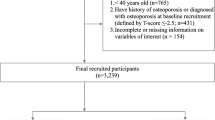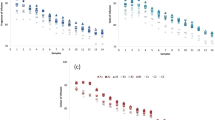Abstract
Tea is a popular drink around the world. It is also one of the major sources of fluoride intake. The objectives of this study were to assess fluoride concentrations in popular non-, semi-, and full-fermented tea drinks sold on the Taiwan market. Concentration differences among three types of commercially available tea drinks (tea leaf, tea bag, and packaged tea beverage) were explored. Several influential factors in intake concentrations were evaluated. The acute threshold intake (ATI) and allowable daily intake (ADI) of those tea drinks were also estimated. For each commercial type, samples from the most popular tea in one particular fermentation degree (non, semi, and full) were randomly purchased and analyzed for fluoride concentrations. Fluoride levels in different rounds of tea, in different containers, and with different ratios of water and tea leaf were also assessed. In total, 132 tea samples were analyzed. The mean fluoride concentrations in leaf tea without the first round, leaf tea with the first round, bagged tea, and packaged tea were 7.04, 7.79, 5.37, and 25.7 mg/l, respectively. Most of the intake concentrations in those samples exceeded 4 mg/l F, the lower bound of fluoride levels reported in the literatures to be associated with a lower IQ in children and a higher risk of bone fracture. Fluoride concentrations in packaged tea were the highest among the three types of commercially available tea. For studied leaf and bagged tea, almost a constant amount of fluoride was infused from the same amount of tea leaf regardless of the water volume. Besides this, making tea with glass or pottery tea makers would not affect fluoride intake concentrations. Acute intoxication is unlikely to occur. However, tea lovers in high fluoride content areas shall consider limit their consumption of tea drinks to avoid potential chronic effects.
This is a preview of subscription content, access via your institution
Access options
Subscribe to this journal
Receive 6 print issues and online access
$259.00 per year
only $43.17 per issue
Buy this article
- Purchase on Springer Link
- Instant access to full article PDF
Prices may be subject to local taxes which are calculated during checkout



Similar content being viewed by others
References
Bardsen A., Klock K.S., and Bjorvatn K. Dental fluorosis among persons exposed to high- and low-fluoride drinking water in western Norway. Community Dent Oral Epidemiol 1999: 27: 259–267.
Cao J., Bai X., Zhao Y., Liu J., Zhou D., Fang S., Jia M., and Wu J. The relationship of fluorosis and brick tea drinking in Chinese Tibetans. Environ Health Perspect 1996: 104: 1340–1343.
Central Weather Bureau. Climatological Data Annual Report: Part I. Surface Data (Taiwan Area). Central Weather Bureau, Ministry of Transportation and Communications, Executive Yuan, Republic of China, 1999.
Fung K.F., Zhang Z.Q., Wong J.W.C., and Wong M.H. Fluoride contents in tea and soil from tea plantations and the release of fluoride into tea liquor during infusion. Environ Pollut 1999: 104: 197–205.
Galagan D.J., and Vermillion J.R. Determining optimum fluoride concentrations. Public Health Rep 1957: 72: 491–493.
Galagan D.J., Vermillion J.R., Nevitt G.A., Stadt A.M., and Dart R.E. Climate and fluid intake. Public Health Rep 1957: 72: 485–490.
Gulati P., Singh V., Gupta M.K., Vaidya V., Dass S., and Prakash S. Studies on the leaching of fluoride in tea infusions. Sci Total Environ 1993: 138: 213–222.
Huang T.Y. (Ed.). Chinese Tea-Making, Chang Wen Publishers, Taipei, Taiwan, 1991, pp. 81–145.
Institute of Occupational Safety and Health (IOSH). Development of an Occupation Referent Population for Epidemiological Study. Institute of Occupational Safety and Health. Council of Labor Affairs, Executive Yuan, Republic of China, 2000; 759 IOSH88-M301.
Ismail A.I., and Messer J.G. The risk of fluorosis in students exposed to a higher than optimal concentration of fluoride in well water. J Public Health Dent 1996: 56: 22–27.
Karthikeyan G., Pius A., and Apparao B.V. Contribution of fluoride in water and food to the prevalence of fluorosis in areas of Tamil Nadu in South India. Fluoride Q Rep 1996: 29: 151–155.
Kumar J.V., and Swango P.A. Fluoride exposure and dental fluorosis in Newburgh and Kingston, New York: policy implications. Community Dent Oral Epidemiol 1999: 27: 171–180.
Li Y.M., Liang C.K., Shemenda C.W., Ji R.D., Sun S.Z., Cao J.X., Emsley C.L., Ma F., Wu Y.P., Ying P., Zhang Y., Gao S.J., Zhang W., Katz B.P., Niu S.R., Cao S.R., and Johnston C.C. Effect of long-term exposure to fluoride in drinking water on risks of bone fractures. J Bone Miner Res 2001: 16: 932–939.
Sowers M.R., Clark M.K., Jannausch M.L., and Wallace R.B. A prospective study of bone mineral content and fracture in communities with differential fluoride exposure. Am J Epidemiol 1991: 133: 649–659.
United States Environmental Protection Agency. Integrated Risk Information System. Washington, DC: United States Environmental Protection Agency, 1989, last revised June 1.
United States Food and Drug Administration. Department of Health and Human Services. Code of Federal Regulations, Title 21: Part 165. Beverages. Rockville, MD: Department of Health and Human Services, United States Food and Drug Administration, 2000: Vol. 2 revised as of April 1.
Villa A.E., Guerrero S., and Villalobos J. Estimation of optimal concentration of fluoride in drinking water under conditions prevailing in Chile. Community Dent Oral Epidemiol 1998: 26: 249–255.
Whitford G.M. Fluoride in dental products: safety considerations. J Dent Res 1987: 66: 1056–1060.
World Health Organization. Water, Sanitation and Health: Guidelines for Drinking Water Quality: Vol. 1. Recommendations, 2nd ed. World Health Organization, Geneva, 1993, pp. 47.
World Health Organization. Water, Sanitation and Health: Guidelines for Drinking Water Quality: Vol. 2. Health Criteria and Other Supporting Information, 2nd ed. World Health Organization, Geneva, 1996, pp. 231–237.
Yang C.Y., Cheng M.F., Tsai S.S., and Hung C.F. Fluoride in drinking water and cancer mortality in Taiwan. Environ Res Sect A 2000: 82: 189–193.
Zhao L.B., Liang G.H., Zhang D.N., and Wu X.R. Effect of a high fluoride water supply on children's intelligence. Fluoride 1996: 29: 190–192.
Author information
Authors and Affiliations
Corresponding author
Rights and permissions
About this article
Cite this article
Lung, SC., Hsiao, PK. & Chiang, KM. Fluoride concentrations in three types of commercially packed tea drinks in Taiwan. J Expo Sci Environ Epidemiol 13, 66–73 (2003). https://doi.org/10.1038/sj.jea.7500259
Received:
Published:
Issue Date:
DOI: https://doi.org/10.1038/sj.jea.7500259
Keywords
This article is cited by
-
Safety Evaluation of Fluoride Content in Tea Infusions Consumed in the Azores—a Volcanic Region with Water Springs naturally Enriched in Fluoride
Biological Trace Element Research (2017)
-
Sources and toxicity of fluoride in the environment
Research on Chemical Intermediates (2013)
-
Potential exposure and risk of fluoride intakes from tea drinks produced in Taiwan
Journal of Exposure Science & Environmental Epidemiology (2008)
-
Fluoride in Ceylon tea and its implications to dental health
Environmental Geochemistry and Health (2007)



